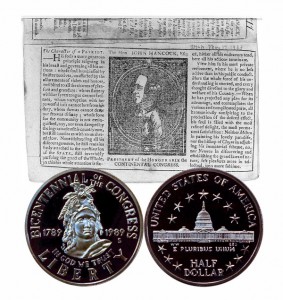Today, the Congress Commemorative Half Dollar Coin remembers 238 years ago when the Second Continental Congress moved to York, Pennsylvania.
George R. Prowell in his book, Continental Congress at York, Pennsylvania, described the solemn occasion:
=====
When Congress convened at York, September 30, 1777, in the minds of some of its members and many people of the United States, there was little hope that the army under Washington would eventually defeat the British forces in America.
At that time, everything was dark and foreboding and the success of the War for Independence seemed doubtful.
The patriots who came here, however, continued to legislate for the army and the establishment of the freedom of the United States.
While Congress held its sessions in York, it passed the Articles of Confederation, which, when adopted, made the Declaration of Independence a reality.
It received the news of the surrender of Burgoyne’s army at Saratoga; made Baron Steuben a major-general and sent him to the headquarters of the army to drill the American soldiers in the military tactics used by Frederick the Great of Prussia.
It received the news from the American commissioners at Paris that the French nation had entered into a treaty of Alliance with the United States, and would send money, a fleet and an army to aid in the struggle for American independence.
It was during the month of June, 1778, that Congress at York, and Washington at Valley Forge planned the campaign resulting in the victory over the enemy at Monmouth, which transferred the seat of the war to the south.
Continental Congress sat for a brief period at Princeton, one day at Lancaster, about two months at Baltimore, and a short time at Annapolis, but transacted no business at these places of importance to the nation.
While in session at York, some of the greatest event in the whole history of the Revolution occurred.
=====
One of those patriots working at York was John Hancock.
Godey’s Magazine of August 1896 mentioned the almanac that first printed a portrait of John Hancock, the president of the Second Continental Congress from May 1775 to October 1777.
The almanac also defined the “patriot.”
=====
One of the most interesting, as well as one of the rarest, of early American almanacs is a curious little book for 1777, called “Bickerstaff’s Boston Almanack.”
This, the inscription reads, was printed and sold by John Boyle in Marlborough Street, and Draper and Phillips, one door north of the Lamb Tavern in Newbury Street. The price of it was sixpence, but those who purchased by the dozen got them for four shillings.
The great rarity of this almanac now, which makes it worth more dollars than the number of pence which it was originally sold for, is due to the fact that it contains the first printed portrait of John Hancock, the noble American patriot and first President of our Provincial Congress.
This portrait, which gives the almanac a sort of revolutionary character, is a decidedly crude engraving, and considerable speculation has arisen regarding the probable engraver.
Many have thought that it might have been Paul Revere, who, however, is better known for his famous ride than for his abilities in the art of engraving; but in the latter respect, he is one of the earliest as well as one of the best that America had.
If it could be proved that this picture of Hancock was the work of Paul Revere, the value of the almanac would be enhanced several times, but as there are no distinguishing marks on the picture, the problem may never be solved.
The portrait, with a few complimentary allusions, occupies a whole page, and under the heading, ” The Character of a Patriot,” is the following quaint item:
“He feels a more generous Principle reigning in his breast and governing all his actions; whose soul is unbiased by sinister motives, unaffected by the allurements of riches and honors, and blind to all the charms of pleasure and grandeur; whom flattery with her syren tongue cannot fascinate, whom corruption with her powerful bait cannot lure from his duty, whom threats cannot deter, nor frowns dismay; whose love for the community is not extinguished, nay, nor even damped by the ingratitude of his countrymen, but still continues with an unabated glow.
“Notwithstanding all his discouragements, he still remains firmly attached to the constitution of the State, still invariably pursuing the good of the Whole. On this his whole attention is fixed, hither all his endeavors tend, here all his actions terminate.
“View him in his most private retirement, where he is no less active than in his public conduct.
“Here the whole force of his understanding is exerted, and every thought directed to the glory and welfare of his Country.
“When he has projected any plan for its advantage, and contemplates the various and complicated parts all harmoniously conspiring to the production of the de sired effect, his soul is filled with a most refined delight, the most permanent satisfaction.
“Neither Milton, in painting his lovely paradise, nor the Bishop of Cloyne in adjusting his immaterial scheme, no, nor Newton in discovering and establishing the grand laws of nature, felt pleasures more intellectual, joys more sublime.”
=====
The Congress Commemorative Half Dollar Coin shows against an image from that long ago almanac showing the picture of John Hancock and the “Character of a Patriot,” circa 1777.
